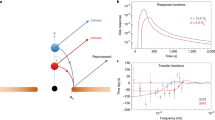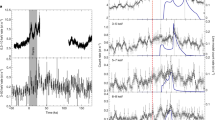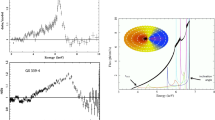Abstract
Luminous accreting stellar mass and supermassive black holes produce power–law continuum X-ray emission from a compact central corona. Reverberation time lags occur due to light travel time delays between changes in the direct coronal emission and corresponding variations in its reflection from the accretion flow. Reverberation is detectable using light curves made in different X-ray energy bands, since the direct and reflected components have different spectral shapes. Larger, lower frequency, lags are also seen and are identified with propagation of fluctuations through the accretion flow and associated corona. We review the evidence for X-ray reverberation in active galactic nuclei and black hole X-ray binaries, showing how it can be best measured and how it may be modelled. The timescales and energy dependence of the high-frequency reverberation lags show that much of the signal is originating from very close to the black hole in some objects, within a few gravitational radii of the event horizon. We consider how these signals can be studied in the future to carry out X-ray reverberation mapping of the regions closest to black holes.
































Similar content being viewed by others
Notes
In Blandford and McKee, and some subsequent optical and X-ray reverberation mapping work (including by the authors of this review), the impulse response is also called the transfer function. However, impulse response is the formally correct signal processing term to describe the time domain response of the system to a delta-function ‘impulse’, which is what we intend here (in signal processing terminology, the transfer function is in fact the Fourier transform of the impulse response).
Even quasi-periodic oscillations seen in XRBs follow the same statistics as noise (van der Klis 1997).
It is important to bear in mind that due to the highly skewed nature of the \(\chi ^{2}_{2}\) distribution, errors on the PSD only approach Gaussian after binning a large number of samples (\(KM>50\)). An alternative approach, which converges more quickly to Gaussian-distributed errors, is to bin \(\log (P_{n,m})\), which also necessitates adding a constant bias to the binned log-power, see Papadakis and Lawrence (1993), Vaughan (2005) for details.
\(n^{2}=[({\bar{P}}_{X} (\nu _{j})-P_{X,\mathrm{noise}})P_{Y,\mathrm{noise}}+({\bar{P}}_{Y}(\nu _{j})-P_{Y,\mathrm{noise}})P_{X,\mathrm{noise}}+P_{X,\mathrm{noise}}P_{Y,\mathrm{noise}}]/KM\), where we assume that the binned PSDs are not already noise-subtracted. See Vaughan and Nowak (1997) for further details.
Since the measured Fourier frequencies depend on segment length, binning is best done by making a frequency-ordered list of frequencies and power or cross-spectral value from all segments and then binning the power/cross-spectra according to frequency.
Strictly speaking, the ‘covariance’ spectrum measures the square root of the covariance of each channel with the reference band.
Note that the description of the calculation of the covariance spectrum and its errors given here should be used instead of that given in Cassatella et al. (2012a), which contains several typos. We would like to thank Simon Vaughan for bringing these errors to our attention.
The covariance spectrum can also be calculated directly from the coherence, using \(Cv(\nu _{j})=\langle x \rangle \sqrt{\gamma ^{2}(\nu _{j})({\bar{P}}_{X}(\nu _{j}) - P_{X,\mathrm{noise}})\varDelta \nu _{j}}\).
I.e. corresponding to half the separation in lag between the 15.87 and 84.13 percentile values of the distribution, which is equivalent to the standard deviation for a Gaussian distribution.
The distributions in the low count rate regime are generated using only 300 realisations instead of \(10^{4}\), due to computational speed limitations.
Black hole masses used by De Marco et al. (2013), Kara et al. (2013c) and in Fig. 12 were obtained from the literature, and estimated primarily using optical broad line reverberation. In a few cases, masses were estimated using the scaling relation between optical continuum luminosity and broad line region radius, which can be used to estimate black hole mass when combined with optical line width (e.g. Kaspi et al. 2000; Grier et al. 2012), or the correlation between black hole mass and host galaxy bulge stellar velocity dispersion (e.g. Gebhardt et al. 2000).
The observed scaling is flatter than expected from a linear relationship, but this can be explained as a bias due to the fact that we only sample the higher frequency end of the soft lag range in the highest mass objects, which leads to systematically shorter lags than would be seen if we could sample the maximum amplitude of soft lags seen at lower frequencies (De Marco et al. 2013).
Formally, a time shift multiplies the Fourier transform by \(\exp (-i\omega \tau _0)\), but here and throughout we use the convention that a positive phase lag corresponds to a delay, so we correct this convention by multiplying the imaginary part of the Fourier transform (and hence the resulting phase lags) by \(-1\).
See also http://stronggravity.eu/public-outreach/animations/reverberation/ for further examples and explanatory animations by M. Dovčiak.
For ATHENA we use the Wide Field Imager (WFI) effective area curve for both cases, since this instrument is able to observe sources with flux up to 1 Crab with minimal signal degradation due to pile-up. However, the high-resolution spectrometer (X-ray Integral Field Unit, X-IFU) will be able to observe fainter sources such as AGN, with only slightly reduced sensitivity compared to the WFI.
References
Alston WN, Vaughan S, Uttley P (2013) MNRAS 435:1511
Alston WN, Done C, Vaughan S (2014) MNRAS 439:1548
Arévalo P, Uttley P (2006) MNRAS 367:801
Arévalo P, Papadakis IE, Uttley P, McHardy IM, Brinkmann W (2006) MNRAS 372:401
Arévalo P, McHardy IM, Summons DP (2008a) MNRAS 388:211
Arévalo P, Uttley P, Kaspi S et al (2008b) MNRAS 389:1479
Barret D (2013) ApJ 770:9
Belloni T, Hasinger G (1990) A&A 227:L33
Bendat JS, Piersol AG (2010) Random data: analysis and measurement procedures, 4th edn. Wiley, New York
Bentz MC et al (2009) ApJ 705:199
Bentz MC, Horne K, Barth AJ et al (2010) ApJ 720:L46
Blandford RD, McKee CF (1982) ApJ 255:419
Cackett EM, Horne K, Winkler H (2007) MNRAS 380:669
Cackett EM, Fabian AC, Zogbhi A et al (2013) ApJ 764:L9
Cackett EM, Zoghbi A, Reynolds C et al (2014) MNRAS 438:298
Campana S, Stella L (1995) MNRAS 272:585
Cassatella P, Uttley P, Maccarone TJ (2012a) MNRAS 427:2985
Cassatella P, Uttley P, Wilms J, Poutanen J (2012b) MNRAS 422:2407
Chainakun P, Young AJ (2012) MNRAS 420:1145
Dasgupta S, Rao AR (2006) ApJ 651:L13
de Avellar MGB, Méndez M, Sanna A, Horvath JE (2013) MNRAS 433:3453
De Marco B, Ponti G, Uttley P et al (2011) MNRAS 417:L98
De Marco B, Ponti G, Cappi M et al (2013) MNRAS 431:2441
Denney KD et al (2010) ApJ 721:715
Emmanoulopoulos D, McHardy IM, Uttley P (2010) MNRAS 404:931
Emmanoulopoulos D, McHardy IM, Papadakis IE (2011) MNRAS 416:L94
Emmanoulopoulos D, Papadakis IE, Dovčiak M, McHardy IM (2014) MNRAS 439:3931
Fabian AC, Ross RR (2010) Space Sci Rev 157:167
Fabian AC, Rees MJ, Stella L, White NE (1989) MNRAS 238:729
Fabian AC, Zoghbi A, Ross RR et al (2009) Nature 459:540
Fabian AC, Kara E et al (2013) MNRAS 429:2917
Feroci M, Stella L, van der Klis M et al (2012) Exp Astron 34:415
Gardner E, Done C (2014) MNRAS 442:2456
Gebhardt K, Kormendy J, Ho LC et al (2000) ApJ 543:L5
Gendreau KC, Arzoumanian Z, Okajima T (2012) In: Society of photo-optical instrumentation engineers (SPIE) conference series, vol 8443
George IM, Fabian AC (1991) MNRAS 249:352
Giannios D, Kylafis ND, Psaltis D (2004) A&A 425:163
Gilfanov M, Churazov E, Revnivtsev M (2000) MNRAS 316:923
Gilfanov M, Revnivtsev M, Molkov S (2003) A&A 410:217
González-Martín O, Vaughan S (2012) A&A 544:A80
Grier CJ, Peterson BM, Pogge RW et al (2012) ApJ 755:60
Grier CJ, Peterson BM, Horne K et al (2013) ApJ 764:47
Guilbert PW, Rees MJ (1988) MNRAS 233:475
Harrison FA, Craig WW, Christensen FE et al (2013) ApJ 770:103
Jin C, Done C, Middleton M, Ward M (2013) MNRAS 436:3173
Kara E, Fabian AC, Cackett EM, Miniutti G, Uttley P (2013a) MNRAS 430:1408
Kara E, Fabian AC, Cackett EM et al (2013b) MNRAS 428:2795
Kara E, Fabian AC, Cackett EM et al (2013c) MNRAS 434:1129
Kara E, Cackett EM, Fabian AC, Reynolds C, Uttley P (2014) MNRAS 439:L26
Kaspi S, Smith PS, Netzer H et al (2000) ApJ 533:631
Kazanas D, Hua X-M, Titarchuk L (1997) ApJ 480:735
Kelly BC, Sobolewska M, Siemiginowska A (2011) ApJ 730:52
Kotov O, Churazov E, Gilfanov M (2001) MNRAS 327:799
Lawrence A, Watson MG, Pounds KA, Elvis M (1987) Nature 325:694
Legg E, Miller L, Turner TJ et al (2012) ApJ 760:73
Lightman AP, White TR (1988) ApJ 335:57
Lyubarskii YE (1997) MNRAS 292:679
Maccarone TJ, Coppi PS, Poutanen J (2000) ApJ 537:L107
Marinucci A, Matt G, Kara E et al (2014) MNRAS 440:2347
Markowitz A, Edelson R, Vaughan S et al (2003) ApJ 593:96
Markowitz A, Papadakis I, Arévalo P et al (2007) ApJ 656:116
Matt G, Perola GC, Piro L, Stella L (1992) A&A 257:63
Matt G, Fabian AC, Ross RR (1993) MNRAS 262:179
McHardy IM, Papadakis IE, Uttley P, Page MJ, Mason KO (2004) MNRAS 348:783
McHardy IM, Gunn KF, Uttley P, Goad MR (2005) MNRAS 359:1469
McHardy IM, Koerding E, Knigge C, Uttley P, Fender RP (2006) Nature 444:730
McHardy IM, Arévalo P, Uttley P et al (2007) MNRAS 382:985
Middleton M, Uttley P, Done C (2011) MNRAS 417:250
Miller L, Turner TJ, Reeves JN, Braito V (2010a) MNRAS 408:1928
Miller L, Turner TJ, Reeves JN et al (2010b) MNRAS 403:196
Misra R (2000) ApJ 529:L95
Miyamoto S, Kitamoto S (1989) Nature 342:773
Miyamoto S, Kitamoto S, Mitsuda K, Dotani T (1988) Nature 336:450
Miyamoto S, Kitamoto S, Iga S, Negoro H, Terada K (1992) ApJ 391:L21
Nandra K, Barret D, Barcons X et al (2013) arXiv:1306.2307
Nayakshin S, Kazanas D (2002) ApJ 567:85
Nowak MA (2000) MNRAS 318:361
Nowak MA, Vaughan BA, Wilms J, Dove JB, Begelman MC (1999) ApJ 510:874
Page CG (1985) Space Sci Rev 40:387
Pancoast A, Brewer BJ, Treu T (2011) ApJ 730:139
Pancoast A, Brewer BJ, Treu T et al (2013) MNRAS submitted, arXiv:1311.6475
Papadakis IE, Lawrence A (1993) MNRAS 261:612
Papadakis IE, Nandra K, Kazanas D (2001) ApJ 554:L133
Paul B (2013) Int J Mod Phys D 22:41009
Peterson BM (1993) PASP 105:247
Peterson BM, Bentz MC (2006) New Astron Rev 50:796
Peterson BM et al (2004) ApJ 613:682
Ponti G, Papadakis I, Bianchi S et al (2012) A&A 542:A83
Potter SM (2000) J Econ Dyn Control 24:1425
Poutanen J (2002) MNRAS 332:257
Poutanen J, Fabian AC (1999) MNRAS 306:L31
Reig P, Kylafis ND, Giannios D (2003) A&A 403:L15
Revnivtsev M, Gilfanov M, Churazov E (1999) A&A 347:L23
Reynolds CS (2000) ApJ 533:811
Reynolds CS, Young AJ, Begelman MC, Fabian AC (1999) ApJ 514:164
Ross RR, Fabian AC (1993) MNRAS 261:74
Ross RR, Fabian AC (2005) MNRAS 358:211
Shapiro II (1964) Phys Rev Lett 13:789
Stella L (1990) Nature 344:747
Tanaka Y, Nandra K, Fabian AC et al (1995) Nature 375:659
Timmer J, Koenig M (1995) A&A 300:707
Uttley P, McHardy IM (2001) MNRAS 323:L26
Uttley P, McHardy IM (2005) MNRAS 363:586
Uttley P, McHardy IM, Papadakis IE (2002) MNRAS 332:231
Uttley P, McHardy IM, Vaughan S (2005) MNRAS 359:345
Uttley P, Edelson R, McHardy IM, Peterson BM, Markowitz A (2003) ApJ 584:L53
Uttley P, Wilkinson T, Cassatella P et al (2011) MNRAS 414:L60
van der Klis M, Hasinger G, Stella L et al (1987) ApJ 319:L13
van der Klis M (1997) In: Babu GJ, Feigelson ED (eds) Statistical challenges in modern astronomy II, p 321
Vaughan S (2005) A&A 431:391
Vaughan BA, Nowak MA (1997) ApJ 474:L43
Vaughan S, Edelson R (2001) ApJ 548:694
Vaughan B, van der Klis M, Lewin WHG et al (1994) ApJ 421:738
Vaughan S, Edelson R, Warwick RS, Uttley P (2003a) MNRAS 345:1271
Vaughan S, Fabian AC, Nandra K (2003b) MNRAS 339:1237
Walton DJ, Zoghbi A, Cackett EM et al (2013) ApJ 777:L23
Wilkins DR, Fabian AC (2011) MNRAS 414:1269
Wilkins DR, Fabian AC (2012) MNRAS 424:1284
Wilkins DR, Fabian AC (2013) MNRAS 430:247
Wilkinson T (2011) PhD thesis, University of Southampton
Wilkinson T, Uttley P (2009) MNRAS 397:666
Young AJ, Reynolds CS (2000) ApJ 529:101
Zoghbi A, Fabian AC (2011) MNRAS 418:2642
Zoghbi A, Fabian AC, Uttley P et al (2010) MNRAS 401:2419
Zoghbi A, Uttley P, Fabian AC (2011) MNRAS 412:59
Zoghbi A, Fabian AC, Reynolds CS, Cackett EM (2012) MNRAS 422:129
Zoghbi A, Reynolds C, Cackett EM (2013a) ApJ 777:24
Zoghbi A, Reynolds C, Cackett EM et al (2013b) ApJ 767:121
Zoghbi A, Cackett EM, Reynolds C et al (2014) ApJ 789:56
Zu Y, Kochanek CS, Peterson BM (2011) ApJ 735:80
Acknowledgments
We would like to thank Simon Vaughan for valuable discussions and comments and Zaven Arzoumanian and the NICER team for providing the latest NICER instrument response. ACF acknowledges support from the European Union Seventh Framework Programme (FP7/2007–2013) under Grant Agreement No. 312789 (STRONGGRAVITY), the UK Science and Technology Facilities Council, and the ERC Advanced Grant FEEDBACK. EK thanks the Gates Cambridge Scholarship. DRW is supported by a CITA National Fellowship.
Author information
Authors and Affiliations
Corresponding author
Rights and permissions
About this article
Cite this article
Uttley, P., Cackett, E.M., Fabian, A.C. et al. X-ray reverberation around accreting black holes. Astron Astrophys Rev 22, 72 (2014). https://doi.org/10.1007/s00159-014-0072-0
Received:
Revised:
Published:
DOI: https://doi.org/10.1007/s00159-014-0072-0




